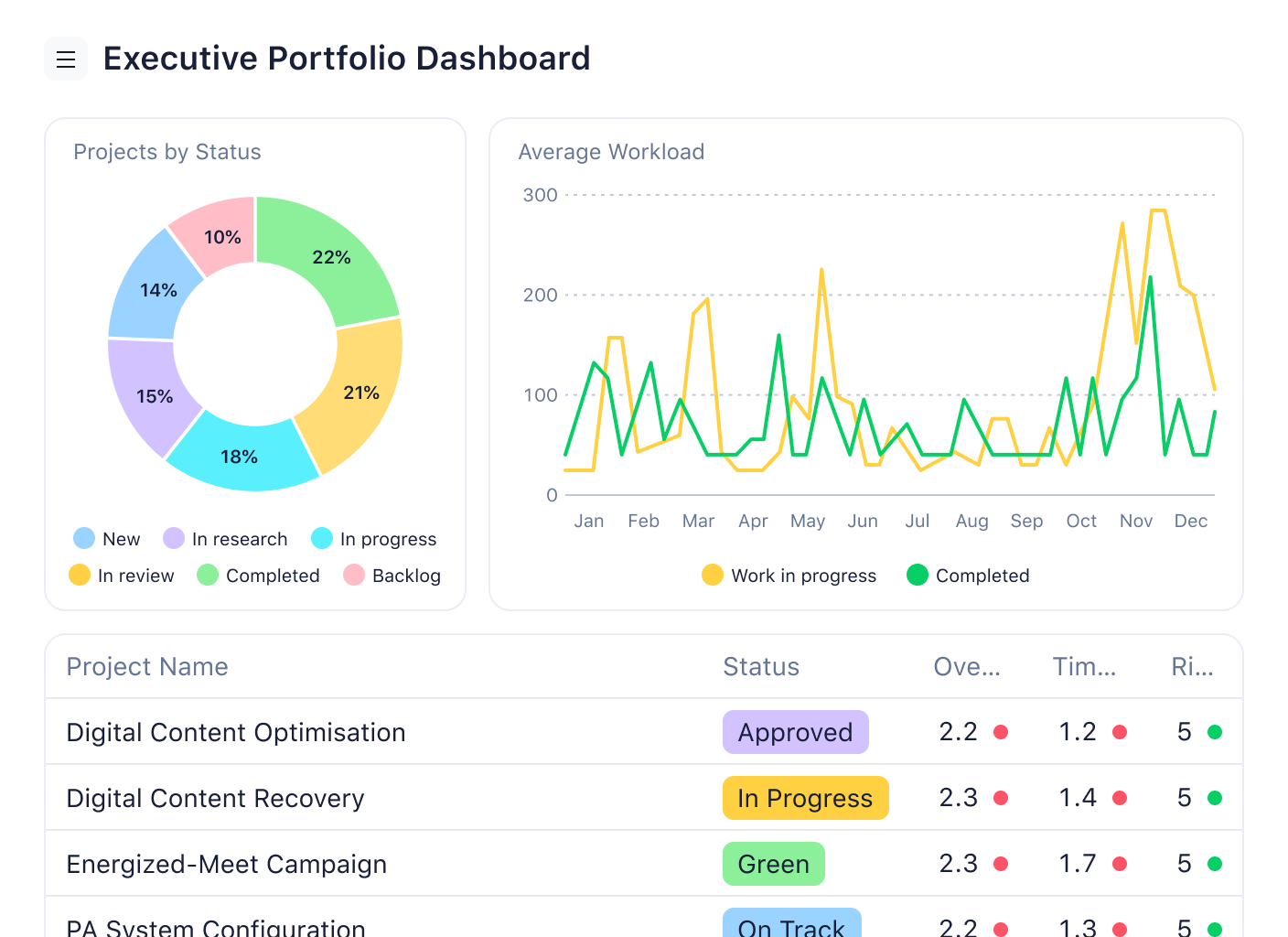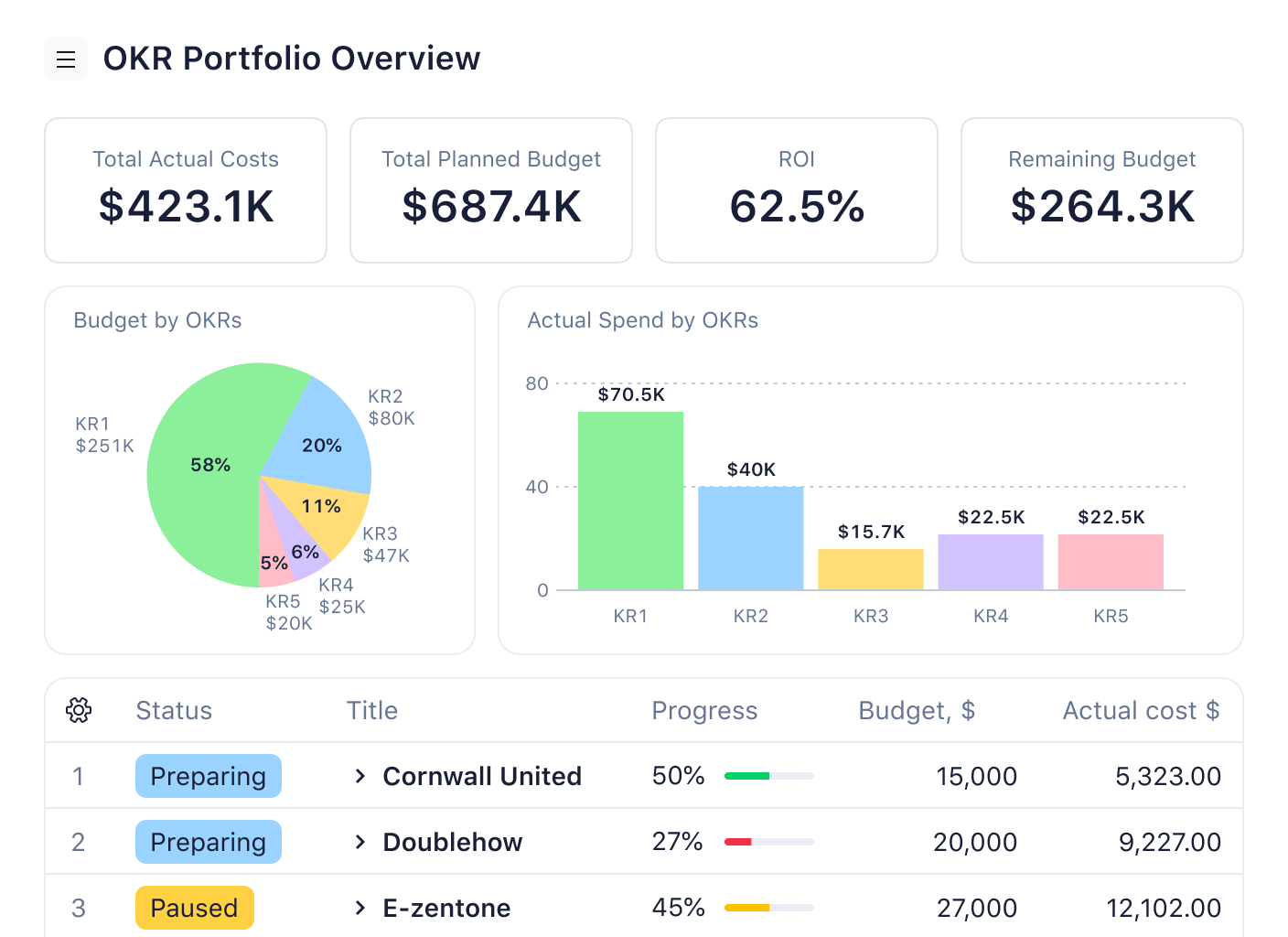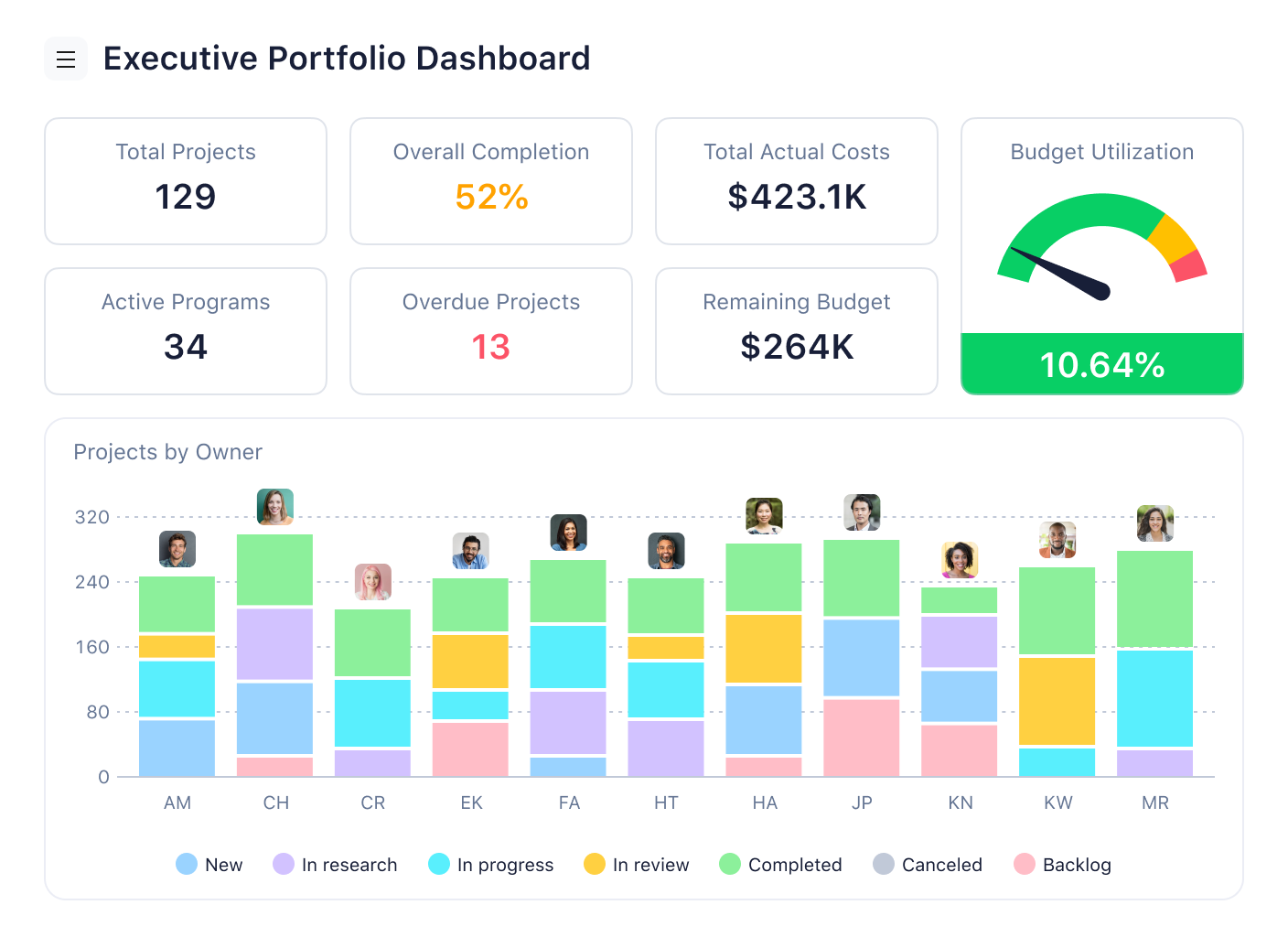What Is Project Portfolio Management (PPM)?
What Is Project Portfolio Management (PPM)?
Project portfolio management (PPM) is the centralized management of an organization's projects. While these projects may or may not be related, they are managed under one umbrella (called a portfolio) to oversee and manage any competing resources. Portfolio management in project management also involves the intake process of projects. This includes identifying potential projects, authorizing them, assigning project managers, and including them in the overall portfolio. It also includes high-level controls and monitoring to ensure ongoing projects are directly related to the business's overall goals and strategies.
Why project portfolio management is important
According to the Project Management Institute, "portfolio management is a way to bridge the gap between strategy and implementation." The portfolio manager's job is to ensure the right projects are being done at the right time to maximize the company's investment. This is particularly important in an organization with a lot of internal projects.
Ideas for projects can come from anywhere, at any time, and it's common for a business to have a long list of potential projects to complete. However, there usually is not enough time, money, or resources to do them all right away. Project portfolio management is necessary to understand which projects will have the largest beneficial impact on the company and prioritize them accordingly.

What types of industries and companies benefit from project portfolio management?
According to research by PM Solutions, 71% of companies have a project portfolio management system. PPM’s growth is evident in the rising number of companies adopting project portfolio management solutions.
However, what kind of companies can benefit from PPM? Project portfolio management is a must-have for any company that has several projects going on simultaneously, such as:
IT
Information technology teams are typically smaller with highly specialized talent and bigger budgets. Resource profiling can be done to update skills inventory and appropriately meet peak demand periods. Use data-driven forecasting to assign the team to value-creating projects. Meet project demands successfully without under or over-burdening the team.
Construction
Often, companies lose focus on their overall goals in the chaos of managing more minor details. For example, large construction projects can take months and even years to complete. Many things may change during that time.
Decreasing project finances, ever-changing stakeholder needs, or the exit of key project personnel can quickly change project dynamics. However, project portfolio management helps keep the focus on the big picture and supports the construction team to keep moving toward its goals.
Financial services
Accuracy is the bedrock of financial services companies such as credit unions, banks, and credit card firms that process payments and manage money. Employing portfolio project management solutions helps companies set up performance thresholds, adapt to changing trends, and gather real-time metrics to meet project objectives.
Project management teams
According to Wellingtone’s State of Project Management report, only 29% of companies complete projects on time. Using project portfolio solutions can be an effective method for minimizing unforeseen delays, mitigating risks, and sequencing projects for maximum success. As a result, stakeholders get more visibility into project prioritization and can understand project value better.
Professional services teams
Professional services teams have different needs based on their size. Smaller companies tend to have fewer projects with smaller budgets, while the larger companies have multiple projects running simultaneously. With a standardized system of workflows and realistic budget estimates, teams can complete their projects faster while minimizing project risks.
Marketing teams
Marketing teams have multiple projects with greatly varying needs. For example, one project may focus on tapping into a new region, while another may be involved in gaining market share in an online marketplace. Marketing teams need to prioritize initiatives that move the overall business goals forward instead of an individual project.
Benefits of project portfolio management
By leveraging the benefits of project portfolio management, companies can plan out all the pieces of their project to get the best results. The main advantages of project portfolio management are:
Provides alignment between company objectives and projects
A PMI survey found that a lack of clearly defined goals is the first reason for project failure. Project portfolio management promotes transparent and open discussions amongst the team with a company-first attitude.

Takes the personal bias out of project planning
With PPM, there are no “pet projects.” Subjectivity in project planning is eliminated as PPM focuses on prioritizing projects based on their inherent risk, business goals, resource, and skill availability. Multiple qualitative and quantitative techniques such as ranking models and scoring methods are used to make project decisions.
Makes decision-making easier
Stakeholders may struggle to manage disputes that can arise with different project teams focusing on their priorities and vying for limited resources. By employing a standardized approach to decision-making, PPM subjectively evaluates the demand from competing project teams.
Helps prioritize projects
Good project portfolio managers focus their limited resources on their most valuable projects. When customer requests, regulatory requirements, or strategy demands arise, teams use project portfolio management to work on viable projects that help achieve organizational goals.
Focuses on the big picture
Sometimes project teams concentrate so much on execution that they miss the big picture. While chasing trends, they fail to achieve strategic goals and overwork their teams. When teams adopt project portfolio management, they prioritize and execute only value-delivering projects.
Builds governance and oversight into project management
Project portfolio management builds a natural governance model for all the projects of an organization. While project management looks at a single project, PPM provides a holistic overview of all projects. Project managers can create a contingency plan, employ data-driven techniques, and lead the company on the right path.
The five steps of project portfolio management
There are five main steps to the project portfolio management process in project management.
1. Identify the guiding objectives of the business
If you work for a grocery store, is their goal to provide the freshest food, the largest selection, or the lowest prices? If the lowest prices are the priority, then projects to promote cost savings are much more important than projects to improve the food's quality.
2. Capture and research requests and ideas
Project ideas could come from anywhere at any time. It's important to have a formalized intake process to capture these ideas so they can be tracked and evaluated. This may be as simple as a spreadsheet maintained by the portfolio manager, or it could be an online database where anyone in the company can enter ideas as they think of them.
3. Select the best projects
Once ideas are captured, portfolio managers must go through a standard process to evaluate and select the projects that will move forward. This requires more than just ensuring they are aligned with the company objectives, such as:
- How much will it cost?
- How long will it take?
- What is the return on this project? (What benefit will it provide?)
- Are the resources available?
- What are the risks associated with this project?
Since decisions are being made on multiple projects at once, this can become even more complex. A common way to simplify the project portfolio management process, and remove any bias, is to create a simple list of criteria that each project is measured and scored against, such as return on investment (ROI), which is a common ranking factor.
4. Validate portfolio feasibility and initiate projects
Once a determination has been made on which projects to move forward, it's important to validate the portfolio as a whole. This can include making sure the mix of projects chosen isn't too large, too risky, too expensive, or too interdependent. The portfolio should be properly balanced and aligned with business goals. For example, if three of your projects forecast testing in January, and you only have one test lab, this is an issue. Also, if two projects are interrelated and a delay in one will push out the other, you may want to reconsider starting them both simultaneously. Once the portfolio is validated, project managers can be assigned and the projects initiated.
5. Manage and monitor the portfolio
Projects change and evolve over time, and new ideas may be added to the list of potential projects. This is why it's important to continually manage both the ongoing portfolio execution and the intake process. Managing and monitoring the portfolio may include the following:
- Working with project managers to monitor the performance of projects
- Identifying and resolving conflicts between projects
- Making changes to the portfolio as needed, including putting projects on hold, canceling projects, and adding in new projects
- Ensuring projects are still aligned with the business objectives
Best tools for project portfolio management
While project portfolio management (PPM) may sound simple, putting the PPM life cycle into action can be challenging. Along with a continuous project planning and evaluation process, you will need the right tools to keep all projects moving forward. Here are some widely used tools for project portfolio management:
Decision tree analysis
Decision tree analysis is a great tool for evaluating situations with multiple subjective factors. It illustrates the multiple ways to solve a problem along with their costs, outcomes, and consequences. Use this method to evaluate project outcomes, identify opportunities, manage costs, and solve problems.
Cost-benefit analysis
A cost-benefit analysis is a quantitative method for assessing the risk and reward of a project. Project success occurs when probable benefits are more and the overall cost is lesser.

Objectives matrix
In this method, the overall business strategy is divided into multiple objectives. These smaller objectives are assigned to different projects and scored for evaluation.
Scoring model
Appraising a project using the scoring model is a good way to balance the quantitative and qualitative factors. Some qualitative factors can be market competitiveness, business value, and customer confidence, while qualitative factors include operational cost, revenue value, and return on investment.
Weights and scores are assigned to these factors, and every project gets a total score. It provides a rational way of comparing projects based on their overall scores.
Why choose Wrike as your project portfolio management solution?
With multiple projects on the go, it’s important to know your team is focusing on the right projects at the right time. You need to combine project management with project portfolio management.
Create business value by focusing on strategic projects to deliver high-impact work. With Wrike, your teams can automate incoming requests, review team workloads, and address bottlenecks before they occur.
Start a free Wrike trial to reduce over-allocation of resources, minimize disruptions, and achieve project portfolio success.

Artem Gurnov
Artem is a Director of Account Development at Wrike. He previously held the role of Project Manager, overseeing a team of customer success managers (CSMs). Over the years of building teams and scaling business processes, he has successfully deployed multiple projects, from automating client outreach to setting up work prioritization tools for sales reps and CSMs.


